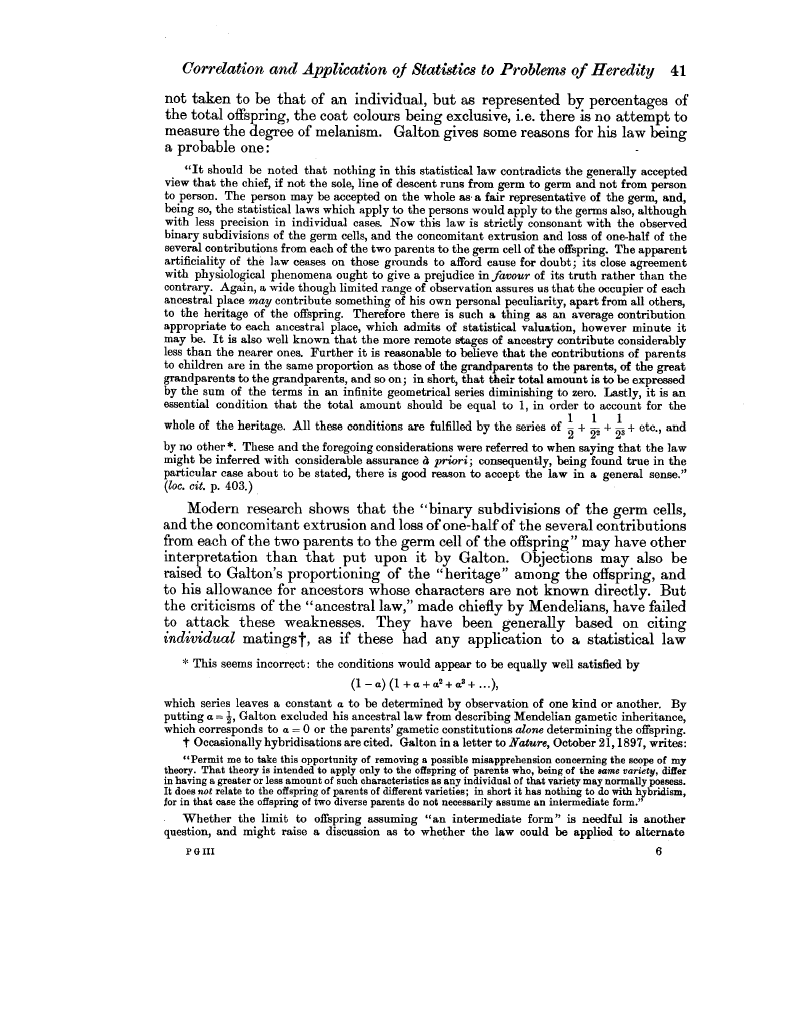| ||||||

OCR Rendition - approximate
Correlation and Application of Statistics to Problems of Heredity 41 not taken to be that of an individual, but as represented by percentages of the total offspring, the coat colours being exclusive, i.e. there is no attempt to measure the degree of melanism. Galton gives some reasons for his law being a probable one "It should be noted that nothing in this statistical law contradicts the generally accepted view that the chief, if not the sole, line of descent runs from germ to germ and not from person to person. The person may be accepted on the whole as, a fair representative of the germ, and, being so, the statistical laws which apply to the persons would apply to the germs also, although with less precision in individual cases. Now this law is strictly consonant with the observed binary subdivisions of the germ cells, and the concomitant extrusion and loss of one-half of the several contributions from each of the two parents to the germ cell of the offspring. The apparent artificiality of the law ceases on those grounds to afford cause for doubt; its close agreement with physiological phenomena ought to give a prejudice in favour of its truth rather than the contrary. Again, a wide though limited range of observation assures us that the occupier of each ancestral place may contribute something of his own personal peculiarity, apart from all others, to the heritage of the offspring. Therefore there is such a thing as an average contribution appropriate to each ancestral place, which admits of statistical valuation, however minute it may be. It is also well known that the more remote stages of ancestry contribute considerably less than the nearer ones. Further it is reasonable to believe that the contributions of parents to children are in the same proportion as those of the grandparents to the parents, of the great grandparents to the grandparents, and so on; in short, that their total amount is to be expressed by the sum of the terms in an infinite geometrical series diminishing to zero. Lastly, it is an essential condition that the total amount should be equal to 1, in order to account for the whole of the heritage. All these conditions are fulfilled by the series of 2 + 23 + 23 + etc., and by no other *. These and the foregoing considerations were referred to when saying that the law might be inferred with considerable assurance d priori; consequently, being found true in the particular case about to be stated, there is good reason to accept the law in a general sense." (loc. cit. p. 403.) Modern research shows that the "binary subdivisions of the germ cells, and the concomitant extrusion and loss of one-half of the several contributions from each of the two parents to the germ cell of the offspring" may have other interpretation than that put upon it by Galton. Objections may also be raised to Galton's proportioning of the "heritage" among the offspring, and to his allowance for ancestors whose characters are not known directly. But the criticisms of the "ancestral law," made chiefly by Mendelians, have failed to attack these weaknesses. They have been generally based on citing individual matings f , as if these had any application to a statistical law * This seems incorrect : the conditions would appear to be equally well satisfied by (1 -a) (1 +a+a2+a3+...), which series leaves a constant a to be determined by observation of one kind or another. By putting a = 1, Galton excluded his ancestral law from describing Mendelian gametic inheritance, which corresponds to a = 0 or the parents' gametic constitutions alone determining the offspring. t Occasionally hybridisations are cited. Galton in a letter to Nature, October 21,1897, writes: "Permit me to take this opportunity of removing a possible misapprehension concerning the scope of my theory. That theory is intended to apply only to the offspring of parents who, being of the same variety, differ in having a greater or less amount of such characteristics as any individual of that variety may normally possess. It does not relate to the offspring of parents of different varieties; in short it has nothing to do with hybridism, for in that case the offspring of two diverse parents do not necessarily assume an intermediate form." Whether the limit to offspring assuming "an intermediate form" is needful is another question, and might raise a discussion as to whether the law could be applied to alternate P 0 111 6
|